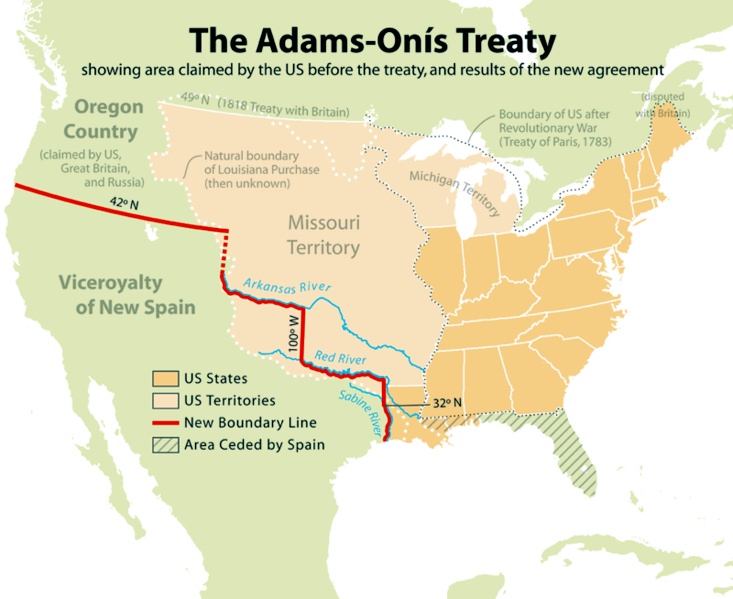|
Treaty of Amity Treaty
of Adams-Onis Acquisition of Florida Purchase of Florida When did Florida Become a State What Year did Florida
become a State When did Florida Receive Statehood Details Maps
Acquisition of Florida:
Treaty of Adams-Onis (1819) and Transcontinental Treaty (1821)
The Adams-Onís Treaty of 1819 (formally titled the Treaty of Amity, Settlement, and Limits Between the
United States of America and His Catholic Majesty. It is also known as the Transcontinental
Treaty of 1819 and the Florida Purchase Treaty)
Under the Onís-Adams Treaty of 1819 (also known as the Transcontinental
Treaty that was ratified in 1821): the United States and Spain defined the western limits of the 1803 Louisiana Purchase; Spain
surrendered its claims to the Pacific Northwest; and the United States recognized Spanish sovereignty over Texas.
The colonies of East Florida and West Florida remained loyal to the British
during the war for American independence, but, by the Treaty of Paris in 1783, they returned to Spanish control.
After 1783, Americans immigrants moved into West Florida. In 1810, these American settlers in West Florida rebelled, declaring
independence from Spain. President James Madison and Congress used the incident to claim the region, knowing full well that
the Spanish government was seriously weakened by Napoleon’s invasion of Spain. The United States asserted that the portion
of West Florida from the Mississippi to the Peridido rivers was part of the Louisiana Purchase of 1803.
| Treaty of Adams-Onis and Transcontinental Treaty |

|
| Treaty of Florida and Acquisition of Florida Map |
At Washington in 1815, negotiations over Florida began in earnest with the
mission of Don Luis de Onís and Secretary of State James Monroe. The issue was not resolved until Monroe was president and
John Quincy Adams was Monroe's Secretary of State. Although U.S. Spanish relations were strained over suspicions of American
support for the independence struggles of Spanish-American colonies, the situation became critical when General Andrew Jackson (Seventh President of the United States) seized the Spanish forts at
Pensacola and St. Marks in his 1818 authorized raid against Seminoles and escaped slaves whom were viewed as a threat to Georgia.
Jackson executed two British citizens on charges of inciting the Indians and runaways. Monroe’s government seriously
considered denouncing Jackson’s actions, but Adams defended Jackson by citing the necessity to restrain the Indians
and escaped slaves since the Spanish failed to do so.
Adams also sensed that Jackson’s Seminole campaign was popular with
Americans and it strengthened his diplomatic hand with Spain.
Adams, pointing to Jackson’s military action, presented Spain with a
demand to either control the inhabitants of East Florida or cede it to the United States. Minister Onís and Secretary Adams
reached an agreement whereby Spain ceded East Florida to the United States and renounced all claim to West Florida. Spain
received no compensation, but the United States agreed to assume liability for $5 million in damage done by American citizens
who had rebelled against Spain.
Sources: U.S. Department of State; Library of Congress
President James Monroe: The Architect of the Monroe Doctrine (The
Monroe Doctrine and Manifest Destiny)
|

